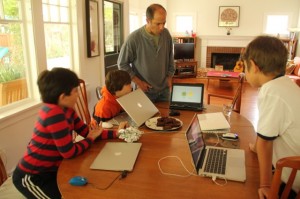 Last week, I met with Sammy Y and the guinea pigs again for another session of Science Through Minecraft. Being our second time together, we were all a little less guinea piggy. We thus moved on to sheep genetics. The night before, I prepared a Google Doc with some concepts, terms, video links, all related to simple Mendelian Genetics: inheritance, DNA, chromosomes, genes, alleles, dominance, recessive, blended inheritance, Punnett squares, probabilities, P-generation, F1, F2, test crosses, Mendel, pea plants, etc. I had forgotten that this was a non traditional lesson so to speak and I had forgotten my audience. Better to be over prepared.
Last week, I met with Sammy Y and the guinea pigs again for another session of Science Through Minecraft. Being our second time together, we were all a little less guinea piggy. We thus moved on to sheep genetics. The night before, I prepared a Google Doc with some concepts, terms, video links, all related to simple Mendelian Genetics: inheritance, DNA, chromosomes, genes, alleles, dominance, recessive, blended inheritance, Punnett squares, probabilities, P-generation, F1, F2, test crosses, Mendel, pea plants, etc. I had forgotten that this was a non traditional lesson so to speak and I had forgotten my audience. Better to be over prepared.
I arrived on time at 11:30 and found the four kids climbing the walls of the living. Sammy Y told them that they could not go on Minecraft until I arrived. As I opened the screen door the kids bolted to the table and booted up their laptops. I guess they enjoyed our first meeting using feathers to investigate whether or not air exists air in Minecraft.
I began the session by asking the three third graders and one fifth grader what they knew about genetics. I quickly realized four clean slates eagerly sat before me. My preparation the night before was overkill and more appropriate for middle school students, but I was totally fine with that. In fact, I found this to be more exciting.
We talked a little about parents, DNA and traits like hair color, height and earlobes. I introduced the term phenotype to mean the visible trait. Great. Within our flat grassland world on the LAN server, one student built a tower so that we could easily orient ourselves. Then we got to “work.” Let’s see how traits are passed on using the color of sheep’s wool. Again this was an authentic question two which I did not know the answer. The kids seem more interested, knowing that we are learning together.
I instructed the kids to do the following: Make a pen roughly 6 or so blocks square; Spawn two sheep in the pen; Pick a color and dye the wool of both sheep that color. Within minutes, 8 sheep were spawned: 2 black, 2 green, 2 orange and 2 lapis in their respective pens. Question: What color wool or phenotype will the baby sheep will have?
FIRST realization: All at once they all shouted out their respective colors. One boy expressed that technically, the lambs should be white because “we had only changed the outside of the sheep and not the DNA or the genes.” In that single thought, he dismissed Lamarck’s theory of inheriting acquired characteristics, i.e. giraffes passing on their stretched necks to their offspring.
Moving on: with wheat in hand, right clicking on both sheep, hearts floated all around and low and behold, a little lamb the same color as the parents appeared. My hope was to have the kids do this ten or so more times to determine if the sheep breed true for wool color. But that seemed obvious to them and they had other ideas. “Can I use another color?” Absolutely, but keep one sheep the same as the first ones you mated. And the fun began. I was determined to let the kids lead the way and not have this be like “school.”
SECOND Realization: “Wow. A light green sheep was made when I mated a dark green sheep with gray one.” This boy just discovered for himself the idea of blended inheritance (often referred to as incomplete dominance), where the phenotype of the offspring appears to be in between the two parental phenotypes. View pen on the right in the screenshot below.
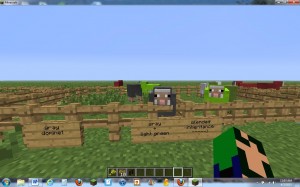 We continued on. Some kids began to realize as they mated sheep with different color wool, some wool color seemed to always appear in the baby sheep. Why? I asked. “Because that color is stronger.” That is true, but geneticists have another term for it: dominant. Later I introduced the term recessive as referring to the weaker or masked phenotype. With that new found knowledge the kids began declaring “purple is dominant over blue,” “Black is dominant over light blue.” “I am going to try black and orange.” etc…
We continued on. Some kids began to realize as they mated sheep with different color wool, some wool color seemed to always appear in the baby sheep. Why? I asked. “Because that color is stronger.” That is true, but geneticists have another term for it: dominant. Later I introduced the term recessive as referring to the weaker or masked phenotype. With that new found knowledge the kids began declaring “purple is dominant over blue,” “Black is dominant over light blue.” “I am going to try black and orange.” etc…
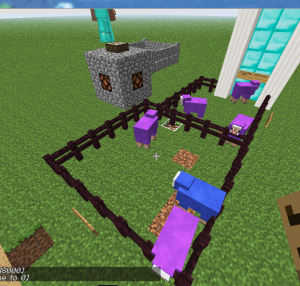
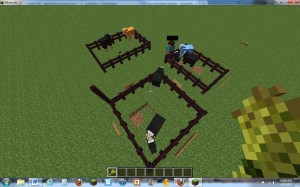
Then I pointed out that just to be sure they should mate the same colors several times in separate crossings and this is where the really cool stuff began to happen. Notice in the screenshot below what has happened with the blue and black sheep and the pen with two orange and one black.
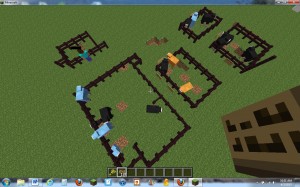 “Black is not always dominant over blue!” This was getting interesting. I encouraged the kids to repeat there experiments to generate more confidence in their results. It was not as straightforward as it first appeared to be. After doing several more matings or crosses of the blue and black sheep, one boy exclaimed “Oh, I just found something totally interesting! One out of three times mating blue and black the baby sheep is black.”
“Black is not always dominant over blue!” This was getting interesting. I encouraged the kids to repeat there experiments to generate more confidence in their results. It was not as straightforward as it first appeared to be. After doing several more matings or crosses of the blue and black sheep, one boy exclaimed “Oh, I just found something totally interesting! One out of three times mating blue and black the baby sheep is black.”
Another boy after 3 matings of orange and black produced all orange offspring, he proclaimed “orange is dominant over black.” After 5 matings, 4 orange sheep were produced and one black. 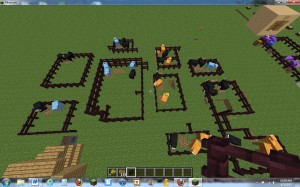
“Wait- can we try cross breeding sheep and pigs?” Why wouldn’t that work? I asked. (I should of encouraged them to try- wouldn’t that have been a shocker if it worked?) Another student quickly chimed in “because they are totally different species.”
Finally, one kid stated “there is a 75% chance of getting green and a 25% chance of getting blue when you mate green and blue sheep.” After a 4th mating, he declared 50:50. The point to me was that he was talking in probabilities! He was predicting the statistical outcomes of the phenotypes in a similar way geneticists do. This was cool!
Time to close the computers and introduce the kids to a 19th century monk named Gregory Mendel. At the same time, we enjoyed some delicious home made brownies.
(TED-ed How Mendel’s pea plants helped us understand genetics)
While I am not so concerned about the accuracy of the kids’ data, it was very exciting to see these boys arrive at some of the very same ideas that early geneticists arrived at.
As I headed out the door, Sammy Y and I were discussing the success of the session, teaching in general and Minecraft. She said something I thought rather interesting: that by investigating how all this works, we were actually getting into the minds of the creators (and programmers) of Minecraft. I agreed. But as I think about it now, Minecraft is an excellent tool to engage kids to figure out how the world works. 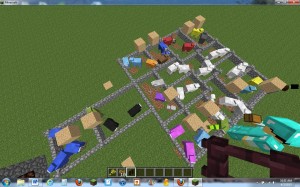 As always, thank you for reading.
As always, thank you for reading.

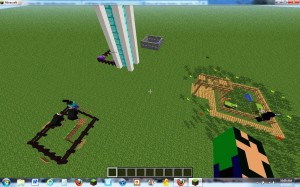

Awesome
Pingback: Tag Team Tech: Wrestling with Teens and Technology June 2014 | VOYA
Love this “lesson” and your narrative of the kids discoveries. I am wondering if you were using MinecraftEDU or regular Minecraft.
Thank you, Kyle. I used regular Minecraft, but EDU would work just as well. I had a student create just a flat grass world and then they set up the various experiments in their area of choosing and they designed themselves. Feel free to email me directly if you like.
Hi Bob,
This looks like it could be a fantastic experience for the students to run experiments and develop their understanding. A question about it all though:
Did you figure out anything concrete about dominant or recessive traits (colours) or is everything simply 50/50 (green sheep plus orange sheep gives half offspring green and half offspring orange)?
Just to know going in. I think that it could still be a great experience, but important to know some background information.
Thank for any input you can give.
Regards,
Marcello
Marcello,
Thank you for your comment. This what a bit ago and I do not remember if we actually found any real dominance or not. Either way, I think this would be a great way to generate interest and understanding of genetics before having kids explore Mendel’s pea plant experiments.
Cheers,
Bob
What world were you in?
LAN- not a public world.
Bummer. Is there a way I can access this?
Pingback: Mendelian Genetics in Minecraft – 7th grade Science | Middle School Minecraft